
Aphids are small sap-sucking insects and members of the superfamily Aphidoidea. Common names include greenfly and blackfly, although individuals within a species can vary widely in color. The group includes the fluffy white woolly aphids. A typical life cycle involves flightless females giving live birth to female nymphs—who may also be already pregnant, an adaptation scientists call telescoping generations—without the involvement of males. Maturing rapidly, females breed profusely so that the number of these insects multiplies quickly. Winged females may develop later in the season, allowing the insects to colonize new plants. In temperate regions, a phase of sexual reproduction occurs in the autumn, with the insects often overwintering as eggs.

Formica is a genus of ants of the family Formicidae, commonly known as wood ants, mound ants, thatching ants, and field ants. Formica is the type genus of the Formicidae, and of the subfamily Formicinae. The type species of genus Formica is the European red wood ant Formica rufa. Ants of this genus tend to be between 4 and 8 mm long. Ants belonging to the Formica genus possess a single knob or bump located between their thorax and abdomen. These ants primarily feed on honeydew, a sugary liquid produced by aphids. Interestingly, Formica ants appear to take on a shepherding role with smaller aphids, relocating them to different parts of plants to ensure a continuous food source for the aphids. By doing so, the ants can establish a relatively sustainable honeydew supply for both themselves and their colony.
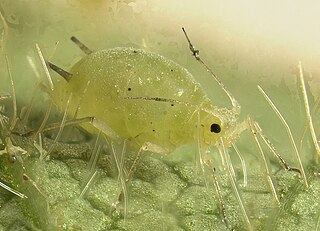
The Aphididae are a very large insect family in the aphid superfamily (Aphidoidea), of the order Hemiptera. These insects suck the sap from plant leaves. Several thousand species are placed in this family, many of which are considered plant/crop pests. They are the family of insects containing most plant virus vectors with the green peach aphid being one of the most prevalent and indiscriminate carriers.
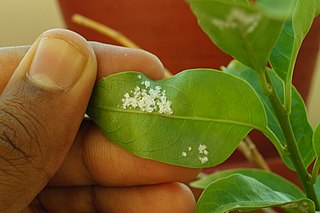
Woolly aphids are sap-sucking insects that produce a filamentous waxy white covering which resembles cotton or wool. The adults are winged and move to new locations where they lay egg masses. The nymphs often form large cottony masses on twigs, for protection from predators.
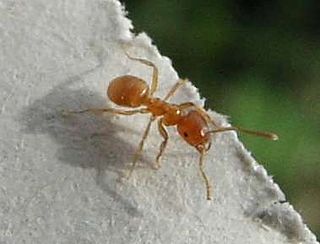
The yellow meadow ant, also known as the yellow hill ant, is a species of ant occurring in Europe, Asia, and North Africa. Populations in North America are now considered a different, related species, Lasius brevicornis.

Myrmecophily is the term applied to positive interspecies associations between ants and a variety of other organisms, such as plants, other arthropods, and fungi. Myrmecophily refers to mutualistic associations with ants, though in its more general use, the term may also refer to commensal or even parasitic interactions.

Trophobiosis is a symbiotic association between organisms where food is obtained or provided. The provider of food in the association is referred to as a trophobiont. The name is derived from the Ancient Greek τροφή (trophē), meaning "nourishment", and -βίωσις (-biosis), which is short for the English word symbiosis.

The black bean aphid is a small black insect in the genus Aphis, with a broad, soft body, a member of the order Hemiptera. Other common names include blackfly, bean aphid, and beet leaf aphid. In the warmer months of the year, it is found in large numbers on the undersides of leaves and on the growing tips of host plants, including various agricultural crops and many wild and ornamental plants. Both winged and wingless forms exist, and at this time of year, they are all females. They suck sap from stems and leaves and cause distortion of the shoots, stunted plants, reduced yield, and spoiled crops. This aphid also acts as a vector for viruses that cause plant disease, and the honeydew it secretes may encourage the growth of sooty mould. It breeds profusely by live birth, but its numbers are kept in check, especially in the later part of the summer, by various predatory and parasitic insects. Ants feed on the honeydew it produces, and take active steps to remove predators. It is a widely distributed pest of agricultural crops and can be controlled by chemical or biological means. In the autumn, winged forms move to different host plants, where both males and females are produced. These mate and the females lay eggs which overwinter.
Cinara pilicornis, the spruce shoot aphid or brown spruce shoot aphid, is an aphid species in the genus Cinara found on Norway spruce and Sitka spruce. It is a quite large aphid species with a plump, dull brown body. It seems to have little effect on the tree. It is a European species but it has also been reported in spruce forests in New Zealand, together with the spruce aphid.

Aphis craccivora, variously known as the cowpea aphid, groundnut aphid or black legume aphid, is a true bug in the family Aphididae. Originally of probable Palearctic origin, it is now an invasive species of cosmopolitan distribution.

Aphis spiraecola is a species of aphid described in 1914 by Edith Marion Patch. Its common names include green citrus aphid, Spirea aphid, and apple aphid. It is distributed worldwide, and is most abundant in the United States. It has a diploid chromosome number of 2n=8.
Cinara confinis, the black stem aphid, is a species of aphid in the genus Cinara, found feeding on the twigs of various species of fir (Abies) and on several other species of coniferous trees. This aphid has a Holarctic distribution and is known from Europe, Asia, North America and Argentina.

Aphis pomi, commonly known as the apple aphid, or the green apple aphid, is a true bug in the family Aphididae. It is found on young growth of apple trees and on other members of the rose family where it feeds by sucking sap. Reproduction is mainly by parthenogenesis, in which unmated females give birth to live young.
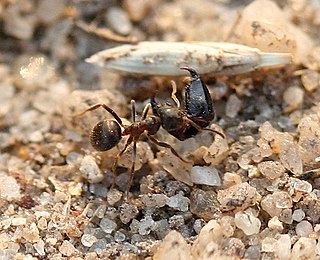
Lasius japonicus is a species of ant belonging to the genus Lasius, that are commonly found throughout East Asia. The species has been observed spraying formic acid both defensively and offensively. It is also known to tend to aphids in exchange for their honeydew secretions, and have been found to be far more attentive to their aphids then other similar ant species. In appearance they are mostly black in color with a tinge of white on their gaster.
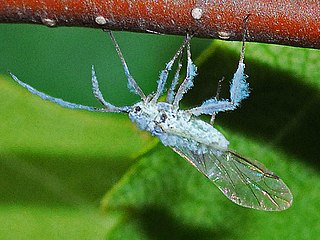
Phyllaphis fagi, the woolly beech aphid, is a species of aphid in the family Aphididae.

Sitobion is a genus of aphids in the family Aphididae. There are more than 80 described species in Sitobion.

Hyperomyzus is a genus of aphids in the family Aphididae. There are more than 20 described species in Hyperomyzus.

Tamalia is a genus of aphids in the family Aphididae. There are eight described species in Tamalia.

Chaitophorus is a genus of aphids first described by Carl Ludwig Koch in 1854. This genus includes roughly 90 to 110 species, and is found in North America, Europe, and Asia.
Metopeurum is a genus of true bugs belonging to the family Aphididae.

















